Blog
Teens and Plantar Warts
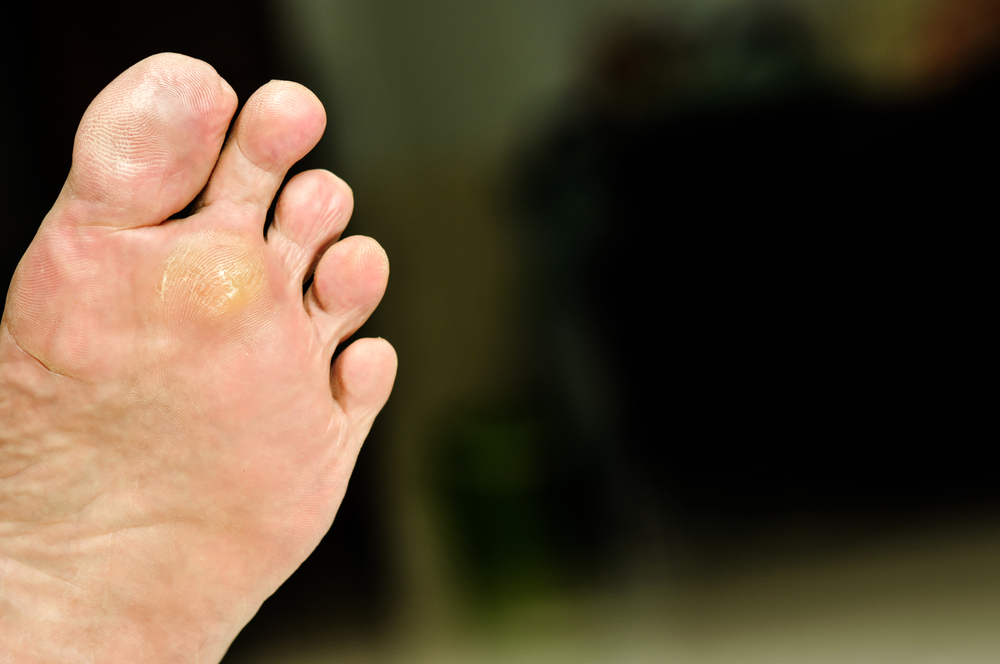
A wart is a growth on the skin caused by over 100 types of the human papillomavirus (HPV). The virus causes a thickening of the top skin layer. Plantar warts occur on the soles of the feet. These can look and feel like calluses. Anyone can get warts, but children aged 12 to 16 and those who have HIV, organ transplants, or are on chemotherapy are at the highest risk for them. Warts are often acquired from a person that has the virus. While not highly contagious, the virus can enter the skin through small cuts or cracks. It is suggested that towels and other intimate objects not be shared, and shoes be worn in public places. Warts are typically harmless and painless, but plantar warts might feel tender when walked on. These warts can be small, or they can grow to cover most of the sole of the foot. They often go away on their own, but this can take up to two years. If your teen has a plantar wart that is bothersome or interferes with their normal daily activities, please consult a podiatrist for treatment options.
Plantar warts can be very uncomfortable. If you need your feet checked, contact Dr. Douglas Mckay from New Jersey . Our doctor will assist you with all of your foot and ankle needs.
About Plantar Warts
Plantar warts are the result of HPV, or human papillomavirus, getting into open wounds on the feet. They are mostly found on the heels or balls of the feet.
While plantar warts are generally harmless, those experiencing excessive pain or those suffering from diabetes or a compromised immune system require immediate medical care. Plantar warts are easily diagnosed, usually through scraping off a bit of rough skin or by getting a biopsy.
Symptoms
- Lesions on the bottom of your feet, usually rough and grainy
- Hard or thick callused spots
- Wart seeds, which are small clotted blood vessels that look like little black spots
- Pain, discomfort, or tenderness of your feet when walking or standing
Treatment
- Freezing
- Electric tool removal
- Laser Treatment
- Topical Creams (prescription only)
- Over-the-counter medications
To help prevent developing plantar warts, avoid walking barefoot over abrasive surfaces that can cause cuts or wounds for HPV to get into. Avoiding direct contact with other warts, as well as not picking or rubbing existing warts, can help prevent the further spread of plantar warts. However, if you think you have developed plantar warts, speak to your podiatrist. He or she can diagnose the warts on your feet and recommend the appropriate treatment options.
If you have any questions please feel free to contact one of our offices located in Caldwell, and Galloway, NJ . We offer the newest diagnostic and treatment technologies for all your foot and ankle needs.
Foot Care Is Critical for Seniors
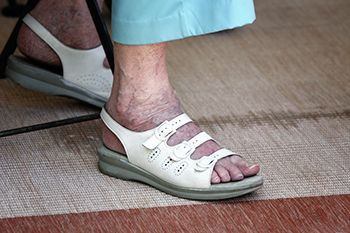
As we age our feet change and things can happen to our feet that affect our overall health and quality of life. Specific foot issues may arise depending on the shoes worn, level of activity, and genetics. With all the wear and tear our feet endure throughout our lifetimes, it’s no wonder there would be stress and strain felt as we age. With aging, our cells hold less water, which in turn can affect collagen, tendons, and ligaments in the feet. Tendons generally get tighter, and ligaments may get looser. With aging, circulation can decline as well as our body’s natural healing ability. Overuse and joint issues are also more common with age. When things in the feet shift, bone spurs can develop, and we can feel pain. To deal with the likely inevitabilities of foot issues, if you are a senior or a caregiver, include a podiatrist in your health care team and schedule regular check-ups.
If you need your feet checked, contact Dr. Douglas Mckay of New Jersey . Our doctor will attend to all of your foot and ankle needs and provide you with quality treatment.
Geriatrics and Podiatry
When people age, some common issues that may occur are bone density loss, dry skin, poor circulation, and rough brittle nails. These issues may also affect your foot health if the necessary steps are not taken to alleviate the problems.
It is important to take care of your feet because feet that are injured or diseased can affect your overall health. Having painful feet hinders your ability to do daily activities or may decrease your willingness to do the things that you need to do.
Visiting Your Geriatrician
As we age, health problems become more likely, so it is essential to visit your doctor for check-ups to ensure that you are doing the best you can to take care of your health. It is recommended to check your feet frequently for any possible cuts, bruises, swelling, corns or any other irregularities.
Taking Care of Elderly Feet
Cracked or dry feet can be treated by applying moisturizer often. It is also important not to wear old socks because the older the sock is, the higher the possibility there will be that there is bacteria there. Wear fresh socks and make sure they fit properly.
Proper foot health means that you can have a more active lifestyle and you will not be bogged down by pain. Foot health also leads to good circulation, which is paramount for overall health.
If you have any questions, please feel free to contact one of our offices located in Caldwell, and Galloway, NJ . We offer the newest diagnostic tools and technology to treat your foot and ankle needs.
Foot Care Is Critical for Seniors

As we age our feet change and things can happen to our feet that affect our overall health and quality of life. Specific foot issues may arise depending on the shoes worn, level of activity, and genetics. With all the wear and tear our feet endure throughout our lifetimes, it’s no wonder there would be stress and strain felt as we age. With aging, our cells hold less water, which in turn can affect collagen, tendons, and ligaments in the feet. Tendons generally get tighter, and ligaments may get looser. With aging, circulation can decline as well as our body’s natural healing ability. Overuse and joint issues are also more common with age. When things in the feet shift, bone spurs can develop, and we can feel pain. To deal with the likely inevitabilities of foot issues, if you are a senior or a caregiver, include a podiatrist in your health care team and schedule regular check-ups.
If you need your feet checked, contact Dr. Douglas Mckay of New Jersey . Our doctor will attend to all of your foot and ankle needs and provide you with quality treatment.
Geriatrics and Podiatry
When people age, some common issues that may occur are bone density loss, dry skin, poor circulation, and rough brittle nails. These issues may also affect your foot health if the necessary steps are not taken to alleviate the problems.
It is important to take care of your feet because feet that are injured or diseased can affect your overall health. Having painful feet hinders your ability to do daily activities or may decrease your willingness to do the things that you need to do.
Visiting Your Geriatrician
As we age, health problems become more likely, so it is essential to visit your doctor for check-ups to ensure that you are doing the best you can to take care of your health. It is recommended to check your feet frequently for any possible cuts, bruises, swelling, corns or any other irregularities.
Taking Care of Elderly Feet
Cracked or dry feet can be treated by applying moisturizer often. It is also important not to wear old socks because the older the sock is, the higher the possibility there will be that there is bacteria there. Wear fresh socks and make sure they fit properly.
Proper foot health means that you can have a more active lifestyle and you will not be bogged down by pain. Foot health also leads to good circulation, which is paramount for overall health.
If you have any questions, please feel free to contact one of our offices located in Caldwell, and Galloway, NJ . We offer the newest diagnostic tools and technology to treat your foot and ankle needs.
Midfoot Arthritis
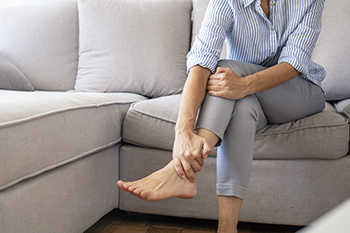
Arthritis is a medical condition that affects a wide variety of individuals across the country. Arthritis primarily impacts the joints of the body, causing them to become inflamed. Individuals who suffer from arthritis can also experience arthritis in their feet. One particular kind of arthritis in the feet is known as midfoot arthritis. This condition occurs at the top, and middle part of the foot when the cartilage between bones diminishes. As a result, the bones can rub up against each other which can ultimately cause inflammation. Certain risk factors are generally associated with midfoot arthritis. For example, suffering from some kind of other foot injury or trauma might make you more susceptible to developing midfoot arthritis. Additionally, one’s natural foot shape might also make one predisposed to developing midfoot arthritis. Schedule an appointment with a podiatrist today for more information.
Arthritis can be a difficult condition to live with. If you are seeking treatment, contact Dr. Douglas Mckay from New Jersey . Our doctor can provide the care you need to keep you pain-free and on your feet.
Arthritic Foot Care
Arthritis is a joint disorder that involves the inflammation of different joints in your body, such as those in your feet. Arthritis is often caused by a degenerative joint disease and causes mild to severe pain in all affected areas. In addition to this, swelling and stiffness in the affected joints can also be a common symptom of arthritis.
In many cases, wearing ill-fitting shoes can worsen the effects and pain of arthritis. Wearing shoes that have a lower heel and extra room can help your feet feel more comfortable. In cases of rheumatoid arthritis, the arch in your foot may become problematic. Buying shoes with proper arch support that contour to your feet can help immensely.
Alleviating Arthritic Pain
- Exercises that stretch the foot can prevent further pain and injury and increase mobility
- Most of the pain can be alleviated with anti-inflammatory drugs, heat, and topical medications
- Massages can help temporarily alleviate pain.
It is best to see your doctor for the treatment that is right for your needs and symptoms. Conditions vary, and a podiatrist can help you determine the right method of care for your feet.
If you have any questions, please feel free to contact one of our offices located in Caldwell, and Galloway, NJ . We offer the newest diagnostic tools and technology to treat your foot and ankle needs.
Midfoot Arthritis

Arthritis is a medical condition that affects a wide variety of individuals across the country. Arthritis primarily impacts the joints of the body, causing them to become inflamed. Individuals who suffer from arthritis can also experience arthritis in their feet. One particular kind of arthritis in the feet is known as midfoot arthritis. This condition occurs at the top, and middle part of the foot when the cartilage between bones diminishes. As a result, the bones can rub up against each other which can ultimately cause inflammation. Certain risk factors are generally associated with midfoot arthritis. For example, suffering from some kind of other foot injury or trauma might make you more susceptible to developing midfoot arthritis. Additionally, one’s natural foot shape might also make one predisposed to developing midfoot arthritis. Schedule an appointment with a podiatrist today for more information.
Arthritis can be a difficult condition to live with. If you are seeking treatment, contact Dr. Douglas Mckay from New Jersey . Our doctor can provide the care you need to keep you pain-free and on your feet.
Arthritic Foot Care
Arthritis is a joint disorder that involves the inflammation of different joints in your body, such as those in your feet. Arthritis is often caused by a degenerative joint disease and causes mild to severe pain in all affected areas. In addition to this, swelling and stiffness in the affected joints can also be a common symptom of arthritis.
In many cases, wearing ill-fitting shoes can worsen the effects and pain of arthritis. Wearing shoes that have a lower heel and extra room can help your feet feel more comfortable. In cases of rheumatoid arthritis, the arch in your foot may become problematic. Buying shoes with proper arch support that contour to your feet can help immensely.
Alleviating Arthritic Pain
- Exercises that stretch the foot can prevent further pain and injury and increase mobility
- Most of the pain can be alleviated with anti-inflammatory drugs, heat, and topical medications
- Massages can help temporarily alleviate pain.
It is best to see your doctor for the treatment that is right for your needs and symptoms. Conditions vary, and a podiatrist can help you determine the right method of care for your feet.
If you have any questions, please feel free to contact one of our offices located in Caldwell, and Galloway, NJ . We offer the newest diagnostic tools and technology to treat your foot and ankle needs.
Do Your Child's Feet Hurt?
Do Your Child's Feet Hurt?
Causes of Ankle Pain Without Having an Injury
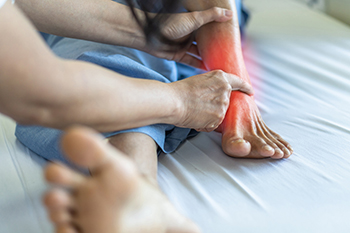
Many people have ankle pain without enduring an injury. It may be noticeable as a shooting pain sears through the ankle, or it may come in the form of mild aches. Arthritis may be the source of ankle pain, in addition to autoimmune disorders which may contribute to developing this type of pain. Gout is a form of arthritis that typically begins in the big toe, and may radiate toward the ankle. It can cause excruciating pain and discomfort, and completing daily activities is often temporarily halted. The condition that is known as flat feet may cause ankle pain, and this may be a result of a lack of shock absorption that is often found in people who have this condition. Additionally, there are specific types of infections that can cause ankle pain, which may travel to the ankle bone. A proper diagnosis is needed to determine the cause of the pain and can be followed by beginning the correct treatment. Any type of ankle pain warrants a visit to the podiatrist, who can effectively treat foot and ankle pain.
Ankle pain can be caused by a number of problems and may be potentially serious. If you have ankle pain, consult with Dr. Douglas Mckay from New Jersey . Our doctor will assess your condition and provide you with quality foot and ankle treatment.
Ankle pain is any condition that causes pain in the ankle. Due to the fact that the ankle consists of tendons, muscles, bones, and ligaments, ankle pain can come from a number of different conditions.
Causes
The most common causes of ankle pain include:
- Types of arthritis (rheumatoid, osteoarthritis, and gout)
- Ankle sprains
- Broken ankles
- Achilles tendinitis
- Achilles tendon rupture
- Stress fractures
- Bursitis
- Tarsal tunnel syndrome
- Plantar fasciitis
Symptoms
Symptoms of ankle injury vary based upon the condition. Pain may include general pain and discomfort, swelling, aching, redness, bruising, burning or stabbing sensations, and/or loss of sensation.
Diagnosis
Due to the wide variety of potential causes of ankle pain, podiatrists will utilize a number of different methods to properly diagnose ankle pain. This can include asking for personal and family medical histories and of any recent injuries. Further diagnosis may include sensation tests, a physical examination, and potentially x-rays or other imaging tests.
Treatment
Just as the range of causes varies widely, so do treatments. Some more common treatments are rest, ice packs, keeping pressure off the foot, orthotics and braces, medication for inflammation and pain, and surgery.
If you have any questions, please feel free to contact one of our offices located in Caldwell, and Galloway, NJ . We offer the newest diagnostic and treatment technologies for all your foot care needs.
How Orthotics Affect Your Feet
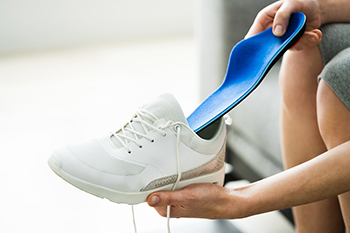
Sometimes the best way to deal with pain in your feet is to wear orthotic devices in your shoes. These inserts can help to support, align, and compensate for deformities you may have that affect your gait or induce pain. Orthotic devices are often recommended for people who have flat feet, as they often cause the foot to roll inward. This movement on a regular basis can further lead to plantar fasciitis, Achilles tendonitis, and other tendon ailments in the foot. If you have flat feet, an orthotic device can compensate by supplying the proper cushioning for the arch, while correcting foot placement. These devices not only can correct the foot problem you may be experiencing, but also help with any leg and knee pain that may result from it. A podiatrist can prescribe a custom orthotic device that best suits your specific needs, taking into account the type of problem, its severity, and its repercussions.
If you are having discomfort in your feet and would like to try orthotics, contact Dr. Douglas Mckay from New Jersey . Our doctor can provide the care you need to keep you pain-free and on your feet.
What Are Orthotics?
Orthotics are inserts you can place into your shoes to help with a variety of foot problems such as flat feet or foot pain. Orthotics provide relief and comfort for minor foot and heel pain but can’t correct serious biomechanical problems in your feet.
Over-the-Counter Inserts
Orthotics come in a wide variety of over-the-counter inserts that are used to treat foot pain, heel pain, and minor problems. For example, arch supports can be inserted into your shoes to help correct overarched or flat feet, while gel insoles are often used because they provide comfort and relief from foot and heel pain by alleviating pressure.
Prescription Orthotics
If over-the-counter inserts don’t work for you or if you have a more severe foot concern, it is possible to have your podiatrist prescribe custom orthotics. These high-quality inserts are designed to treat problems such as abnormal motion, plantar fasciitis, and severe forms of heel pain. They can even be used to help patients suffering from diabetes by treating foot ulcers and painful calluses and are usually molded to your feet individually, which allows them to provide full support and comfort.
If you are experiencing minor to severe foot or heel pain, it’s recommended to speak with your podiatrist about the possibilities of using orthotics. A podiatrist can determine which type of orthotic is right for you and allow you to take the first steps towards being pain-free.
If you have any questions please contact one of our offices located in Caldwell, and Galloway, NJ . We offer the newest diagnostic and treatment technologies for all your foot and ankle needs.
Facts About Hammertoes

If you notice that your toe does not lie flat, but instead has formed a peak in the middle, it is likely that you have developed a hammertoe. Although a hammertoe may be congenital, most develop over time. The main culprits in the latter case are arthritis and ill-fitting footwear. A hammertoe develops when the muscles weaken enough to cause an imbalance in the middle joint of the toe. The muscles tighten and the joint pops up, most often in the 2nd, 3rd, and 4th toe. Women are at higher risk of hammertoes, especially if they frequently wear high heels with pointed toes. These shoes can force the feet into a fixed, flexed position. Other causes include a toe that is stubbed, jammed, or broken. A hammertoe can become painful as the raised part of the joint rubs against the inside of a shoe. Proper footwear is the number one way to prevent a hammertoe. Diagnosis of the severity of a hammertoe will determine the treatment options available to you. Please consult with a podiatrist for an examination and an appropriate treatment plan.
Hammertoe
Hammertoes can be a painful condition to live with. For more information, contact Dr. Douglas Mckay from New Jersey . Our doctor will answer any of your foot- and ankle-related questions.
Hammertoe is a foot deformity that affects the joints of the second, third, fourth, or fifth toes of your feet. It is a painful foot condition in which these toes curl and arch up, which can often lead to pain when wearing footwear.
Symptoms
- Pain in the affected toes
- Development of corns or calluses due to friction
- Inflammation
- Redness
- Contracture of the toes
Causes
Genetics – People who are genetically predisposed to hammertoe are often more susceptible
Arthritis – Because arthritis affects the joints in your toes, further deformities stemming from arthritis can occur
Trauma – Direct trauma to the toes could potentially lead to hammertoe
Ill-fitting shoes – Undue pressure on the front of the toes from ill-fitting shoes can potentially lead to the development of hammertoe
Treatment
Orthotics – Custom made inserts can be used to help relieve pressure placed on the toes and therefore relieve some of the pain associated with it
Medications – Oral medications such as anti-inflammatories or NSAIDs could be used to treat the pain and inflammation hammertoes causes. Injections of corticosteroids are also sometimes used
Surgery – In more severe cases where the hammertoes have become more rigid, foot surgery is a potential option
If you have any questions please contact one of our offices located in Caldwell, and Galloway, NJ . We offer the newest diagnostic and treatment technologies for all your foot and ankle needs.
More...
What Do Cracked Heels Mean?
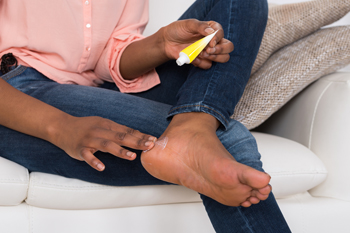
When an individual develops cracked heels, they might notice several things. First, they might see deep cracks, or fissures, on the back of the heel due to a lack of moisture. Second, although many cases are painless, severe cases of cracked heels can be accompanied by pain. Importantly, a case of cracked heels might signal other potential problems to be aware of. It is possible that heel fissures might point to some kind of vitamin deficiency. In others, heel fissures could signal that the individual has developed a related fungal infection. Still in others, some cases of cracked heels might mean that the individual is simply aging. As someone grows older as a senior citizen, they become more susceptible to certain kinds of foot conditions. If you have cracked heels, contact a podiatrist today for assistance.
Cracked heels are unsightly and can cause further damage to your shoes and feet. If you have any concerns, contact Dr. Douglas Mckay from New Jersey . Our doctor can provide the care you need to keep you pain-free and on your feet.
Cracked Heels
Cracked heels appear unappealing and can make it harder for you walk around in sandals. Aside from looking unpleasant, cracked heels can also tear stockings, socks, and wear out your shoes. There are several methods to help restore a cracked heel and prevent further damage.
How Do You Get Them?
Dry skin is the number one culprit in creating cracked heels. Many athletes, walkers, joggers, and even swimmers suffer from cracked heels. Age and skin oil production play a role to getting cracked heels as well.
Promote Healing
Over the counter medicines can help, especially for those that need instant relief or who suffer from chronic dry feet.
Wear Socks – Wearing socks with medicated creams helps lock in moisture.
Moisturizers – Applying both day and night will help alleviate dryness which causes cracking.
Pumice Stones – These exfoliate and remove dead skin, which allows for smoother moisturizer application and better absorption into the skin.
Change in Diet
Eating healthy with a well-balanced diet will give the skin a fresh and radiant look. Your body responds to the kinds of food you ingest. Omega-3 fatty acids and zinc supplements can also revitalize skin tissue.
Most importantly, seek professional help if unsure how to proceed in treating cracked heels. A podiatrist will help you with any questions or information needed.
If you have any questions, please feel free to contact one of our offices located in Caldwell, and Galloway, NJ . We offer the newest diagnostic and treatment technologies for all your foot care needs.
Wounds That Don't Heal Need to Be Checked
Dealing With Diabetic Foot Ulcers

One side effect of diabetes is the increased chance of having sores or wounds on the feet that do not heal properly. If not attended to quickly, these sores can develop into what is known as a diabetic foot ulcer. Research shows that about 20 percent of diabetics have a foot ulcer, and half of the ulcers will become infected. One of the reasons foot ulcers develop is nerve damage caused by high blood sugar levels. The most common locations for ulcers are under the big toe and the ball of the foot, which are often difficult to examine. A foot ulcer that is not treated can spread to the bones or joints and it may develop into gangrene. Prevention of foot ulcers is essential for diabetics. Measures include keeping the feet clean and dry, checking for sores or cuts, and wearing appropriate shoes. If you have diabetes and have noticed numbness in the feet, please contact a podiatrist who can offer treatment solutions.
Diabetic foot care is important in preventing foot ailments such as ulcers. If you are suffering from diabetes or have any other concerns about your feet, contact Dr. Douglas Mckay from New Jersey . Our doctor can provide the care you need to keep you pain-free and on your feet.
Diabetic Foot Care
Diabetes affects millions of people every year. The condition can damage blood vessels in many parts of the body, especially the feet. Because of this, taking care of your feet is essential if you have diabetes, and having a podiatrist help monitor your foot health is highly recommended.
The Importance of Caring for Your Feet
- Routinely inspect your feet for bruises or sores.
- Wear socks that fit your feet comfortably.
- Wear comfortable shoes that provide adequate support.
Patients with diabetes should have their doctor monitor their blood levels, as blood sugar levels play such a huge role in diabetic care. Monitoring these levels on a regular basis is highly advised.
It is always best to inform your healthcare professional of any concerns you may have regarding your feet, especially for diabetic patients. Early treatment and routine foot examinations are keys to maintaining proper health, especially because severe complications can arise if proper treatment is not applied.
If you have any questions please feel free to contact one of our offices located in Caldwell, and Galloway, NJ . We offer the newest diagnostic and treatment technologies for all your foot and ankle needs.
Exercising With Flat Feet

Occasionally, flat feet do not self-correct during childhood but move into adulthood, which may cause pain and discomfort. Those who enjoy working out may find their workouts are compromised as a result of living with flat feet. An effective workout for the legs consists of performing squats, and flat feet may cause the lower part of the leg to roll inward, thus affecting the benefits of this exercise. Flat feet may be improved when the foot structure is strengthened to rebuild the arch. An effective exercise that may help consists of pushing hard on the bone at the bottom of the big toe while trying to create an arch as the toe is pushed down. This is an isometric exercise when held for 20 seconds and frequently repeated. If you would like to acquire more information about how having flat feet can affect your workouts, in addition to learning about strength training foot exercises, please confer with a podiatrist who can help you with any questions you may have.
Flatfoot is a condition many people suffer from. If you have flat feet, contact Dr. Douglas Mckay from New Jersey . Our doctor will treat your foot and ankle needs.
What Are Flat Feet?
Flatfoot is a condition in which the arch of the foot is depressed and the sole of the foot is almost completely in contact with the ground. About 20-30% of the population generally has flat feet because their arches never formed during growth.
Conditions & Problems:
Having flat feet makes it difficult to run or walk because of the stress placed on the ankles.
Alignment – The general alignment of your legs can be disrupted, because the ankles move inward which can cause major discomfort.
Knees – If you have complications with your knees, flat feet can be a contributor to arthritis in that area.
Symptoms
- Pain around the heel or arch area
- Trouble standing on the tip toe
- Swelling around the inside of the ankle
- Flat look to one or both feet
- Having your shoes feel uneven when worn
Treatment
If you are experiencing pain and stress on the foot you may weaken the posterior tibial tendon, which runs around the inside of the ankle.
If you have any questions please feel free to contact one of our offices located in Caldwell, and Galloway, NJ . We offer the newest diagnostic and treatment technologies for all your foot and ankle needs.



